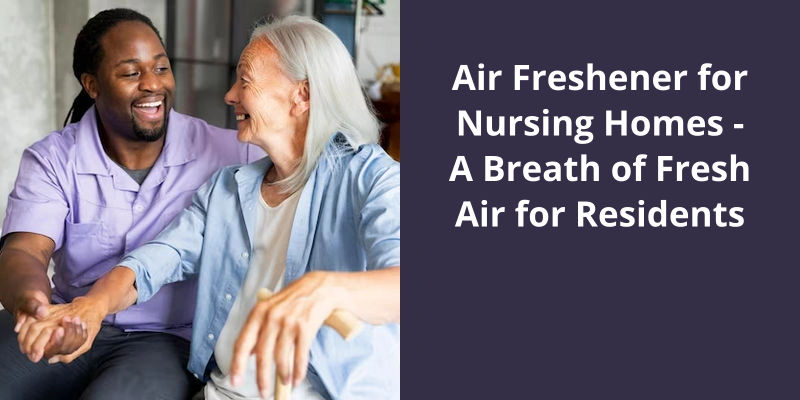Air fresheners for nursing homes are essential for maintaining a clean and pleasant atmosphere, enhancing the quality of life for residents. These products neutralize odors, ranging from food smells to medical odors, making the environment more comfortable. It’s important to choose air fresheners that are non-toxic and free from harsh chemicals as elderly residents can be sensitive to strong fragrances. Examples include natural essential oil diffusers or environmentally-friendly automatic sprays. Also, implementing an air purifier could be beneficial, as these devices not only freshen the air but also filter out particles and allergens. Providing adequate ventilation, keeping all spaces within the nursing home clean, and addressing the source of persistent odors also contribute to a fresh-smelling environment.

What Do Nursing Homes Use to Eliminate Odors?
Air fresheners play a vital role in creating a pleasant and clean environment in nursing homes. These facilities often face challenges in eliminating odors due to the constant presence of various sources, including bodily fluids, medical supplies, and cooking aromas. To tackle this issue, many nursing homes have turned to advanced air purification systems such as Odorox and Pyure.
These systems work by releasing oxidizing molecules that attack and break down odor-causing pollutants at a molecular level. As a result, not only are the odors eliminated, but the bacteria and viruses that may be present in the air are also destroyed.
The use of these systems in nursing homes is particularly important for the well-being of residents. Poor air quality can have a significant impact on the health of elderly individuals, who’re often more susceptible to respiratory issues and infections. By implementing air purification systems, nursing homes can provide residents with a breath of fresh air, reducing the risk of respiratory problems and improving overall comfort.
Moreover, the use of Odorox and Pyure can also contribute to a safer environment in nursing homes. These systems have been tested and proven effective against a wide range of pathogens, including bacteria such as MRSA and viruses such as influenza. By eliminating these harmful microorganisms from the air, the spread of infections within the facility can be minimized, protecting both the residents and the staff.
They can be incorporated into existing HVAC systems or used as standalone units in specific areas of the facility. Furthermore, these systems don’t rely on harsh chemicals or fragrances to mask odors, ensuring a safe and pleasant environment for everyone.
Additionally, these systems offer a practical solution for maintaining a safe and hygienic facility, reducing the risk of respiratory problems and infections.
The Importance of Air Quality in Nursing Homes and It’s Impact on Resident Health
- The link between air quality and resident health in nursing homes
- The role of ventilation systems in maintaining good air quality
- The impact of poor air quality on respiratory health and allergies
- The connection between air pollution and cardiovascular diseases
- The importance of regular maintenance and cleaning of air filters
- Strategies to improve air quality in nursing homes through proper ventilation
- The benefits of using air purifiers and humidifiers in resident rooms
- Educating staff and residents about the importance of clean air
- The role of outdoor air quality in indoor air pollution
- The need for collaboration between nursing homes and environmental agencies to monitor and address air quality issues
Air fresheners are a common household item often used to mask unpleasant odors and create a fresh atmosphere. However, concerns have been raised about their potential impact on our health. Made Safe, an organization dedicated to assessing product safety, has found that many plug-in air fresheners emit harmful chemicals such as endocrine disruptors and carcinogens. These include benzene, formaldehyde, phthalates, toluene, acetaldehyde, and more. Such findings highlight the need for a closer examination of the safety of these commonly used products.
Are Plug-in Air Fresheners Safe for Your Health?
Plug-in air fresheners have become a popular choice for many households, with their ability to quickly mask unpleasant odors and create a fresh and inviting atmosphere. However, recent studies have raised concerns about the potential health hazards associated with these seemingly harmless products. According to Made Safe, an organization dedicated to screening products for potential health hazards, air fresheners can emit a variety of harmful chemicals, including endocrine disruptors and carcinogens.
One such chemical is benzene, a known carcinogen that’s been linked to an increased risk of certain cancers. Formaldehyde, another common ingredient in air fresheners, is also classified as a carcinogen and may have adverse effects on respiratory health. Phthalates, often used as fragrance enhancers, have been associated with hormone disruption and reproductive problems. Toluene, acetaldehyde, and many other chemicals commonly found in air fresheners have been linked to a range of health issues, including respiratory irritation, allergies, and asthma.
These findings are particularly concerning for nursing homes, where the health and well-being of residents should be of utmost importance. Many elderly individuals may already have compromised respiratory systems or underlying health conditions, making them more susceptible to the potential dangers of these chemicals. It’s crucial for nursing homes to consider the potential risks associated with plug-in air fresheners and explore safer alternatives to ensure the health and comfort of their residents.
Fortunately, there are alternative options available that can still provide a breath of fresh air for nursing home residents without compromising their health. Natural air fresheners, such as essential oil diffusers or sachets filled with dried herbs, can effectively eliminate odors while avoiding the use of harmful chemicals. These alternatives not only provide a pleasant scent, but they can also offer additional therapeutic benefits, such as relaxation or improved mood.
Source: The Best Non-Toxic Alternatives To Plug-In Air Fresheners
However, these traditional solutions often only mask or temporarily cover up the odors, rather than addressing the root cause. In recent years, there’s been a shift towards more sustainable and effective methods for odor control in nursing homes.
What Makes a Nursing Home Smell?
Organic materials are the leading cause of odors in nursing homes, including urine, feces, and vomit. These substances can release unpleasant gases and create a pervasive smell that affects the overall ambiance of the facility. Recognizing the importance of creating a pleasant environment for residents, nursing homes have been seeking effective solutions to combat these odors.
Traditionally, three main types of solutions have been used to address odor problems in nursing homes. The first is air fresheners, which typically contain fragrances designed to mask unpleasant smells. While air fresheners provide an immediate burst of pleasant scent, they don’t eliminate the underlying odors. Instead, they temporarily create a more pleasant ambiance.
The second type of solution is odor counteractants, which work by chemically neutralizing the odor molecules. These products often contain chemicals that bind to the odor-causing molecules, altering their chemical structure and reducing their ability to be perceived as unpleasant smells.
Finally, there are odor eliminators, which aim to completely remove odors rather than mask or neutralize them. These products typically contain enzymes or bacteria that break down the organic materials responsible for the odors. By effectively eliminating the source of the smells, odor eliminators provide a more long-lasting solution.
When it comes to choosing the most suitable air freshener for nursing homes, it’s important to consider not only the effectiveness of the product but also the potential negative effects on the health of residents. Certain fragrances and chemicals in air fresheners may trigger allergic reactions or respiratory issues in some individuals, particularly those with sensitivities or compromised immune systems.
While air fresheners offer a temporary solution, odor counteractants and odor eliminators provide more effective ways to tackle the problem. However, it’s essential to consider the potential health risks associated with certain air freshener products.
Strategies for Preventing and Managing Organic Material Odors in Nursing Homes
- Proper ventilation and air circulation
- Routine cleaning and disinfecting of surfaces
- Regular garbage disposal and waste management
- Use of odor-absorbing materials, such as activated charcoal or baking soda
- Proper storage and handling of organic materials
- Regular laundering of linens and fabrics
- Implementing effective pest control measures
- Ensuring proper sewer system maintenance
- Utilizing air fresheners or deodorizers as needed
- Regular inspections and maintenance of plumbing systems
Plug-in air fresheners may not consume a substantial amount of electricity individually, as they typically use around 4 watts. However, when left on continuously, these seemingly inconspicuous devices can add up to 35 units of electricity consumption per year. Additionally, the costly refills and the prevalence of having multiple units per household further contribute to the overall impact.
Do Plug-in Air Fresheners Use a Lot of Electricity?
Plug-in air fresheners are a common feature in many households, including nursing homes, seeking to maintain a pleasant and refreshing environment. However, one may wonder if these devices consume a significant amount of electricity. The answer is relatively simple: a typical plug-in air freshener uses a mere 4 watts of electricity. While this might not seem like much on it’s own, when left on permanently, it can accumulate to 35 units of electricity per year.
In addition to the financial implications, some may worry about the environmental impact of plug-in air fresheners. Considering the number of units necessary in a nursing home setting, the sheer quantity of refills discarded can contribute to unnecessary waste. With sustainability gaining increasing importance, nursing homes may seek alternative solutions that offer both environmental and economic benefits.
Furthermore, it’s crucial to ensure the well-being and comfort of residents in nursing homes. While air fresheners can improve the ambiance, it’s necessary to consider the potential risks associated with the inhalation of certain chemical fragrances. Some individuals may have sensitivities or allergies that could be aggravated by the use of these devices. Therefore, finding a balance between creating a pleasant environment and prioritizing the health and safety of residents is of utmost importance.
The Environmental Impact of Plug-in Air Fresheners: This Topic Would Explore the Potential Harm Caused by the Disposal of Used Air Freshener Refills and the Implications for Waste Management and Sustainability.
- Potential harm caused by disposal of used air freshener refills
- Implications for waste management
- Impact on sustainability
To ensure the health and well-being of residents, nursing homes strictly adhere to guidelines set by the Centres for Disease Control and Prevention (CDC). In their effort to maintain a clean and safe environment, nursing homes enforce a ban on scented or fragranced products of any kind, which includes popular air fresheners like plug-ins and sprays. This restriction ensures that the air quality remains neutral and avoids potential allergic reactions or respiratory problems among residents.
Are Plug in Air Fresheners Allowed in Nursing Homes?
Air fresheners play a crucial role in creating a pleasant and inviting environment, especially in places like nursing homes. However, when it comes to the use of plug-in air fresheners in nursing homes, it’s important to note that regulations and guidelines must be followed. The Centers for Disease Control and Prevention (CDC) has strict rules regarding scented or fragranced products in all interior spaces owned, rented, or leased by them.
This means that the use of such devices, along with incense, candles, reed diffusers, and spray air fresheners, isn’t allowed. These guidelines aim to ensure the health and well-being of the residents by preventing potential respiratory irritations or sensitivities caused by the scent molecules emitted from these products.
Many elderly individuals have respiratory problems, allergies, or sensitivities to strong scents, which can worsen their conditions or even cause discomfort.
Instead of relying on plug-in air fresheners, nursing homes can explore alternative methods to maintain a fresh and pleasant environment for their residents. This can include regular cleaning and ventilation practices, the use of natural odor absorbers such as baking soda or activated charcoal, and the incorporation of fresh flowers or plants that naturally emit a pleasant fragrance.
It’s important to create a space that isn’t only free from strong scents but also promotes clean air and a comfortable living environment for all.
The Potential Risks and Benefits of Using Plug-in Air Fresheners in Nursing Homes
- Improved air quality and pleasant fragrance
- Enhanced ambiance and a more welcoming environment
- Potential reduction in unpleasant odors
- Positive impact on residents’ mood and well-being
- Potential masking of underlying hygiene issues
- Potential respiratory irritation or allergy-triggering
- Possible negative effects on individuals with respiratory conditions
- Potential overload of chemical pollutants in the air
- Possible interference with medication or treatment effectiveness
- Risk of accidental ingestion or misuse by residents
Conclusion
By eliminating nursing home and hospice sick room smells without compromising the health of residents, these granules provide a breath of fresh air for both residents and staff. The unique formula of the Smelleze granules ensures that offensive odors are neutralized at their source, thus creating a truly fresh and inviting environment in which residents can thrive. Furthermore, their natural ingredients make them a safe and eco-friendly option.





